Table of Contents
What Does “Active Brake Assist Functions Limited” Mean?
This warning appears on the dashboard when the Active Brake Assist system detects a malfunction. It means the automatic emergency braking feature may not work properly, and you should drive cautiously and have the system checked.
As vehicles evolve with sophisticated safety technologies, active brake assist mercedes stands out as a key system that helps prevent or lessen the impact of collisions by applying the brakes automatically during critical moments.
Active Brake Assist Functions Limited becomes relevant when drivers see a warning on their dashboard, indicating that the system may not be operating at full capacity. Like any advanced tech, Active Brake Assist is not immune to faults issues may arise due to sensor misalignment, electrical faults, or software errors.
Active Brake Assist Functions Limited is best understood through real-world applications. This article highlights two actual case studies where vehicles displayed this specific warning. We’ll walk you through how technicians diagnosed the problems using scan tools, performed component-level inspections, and applied targeted solutions.
Whether you’re a professional troubleshooting a complex issue or a car owner wanting to understand your vehicle better, these examples offer practical guidance and tips to restore full functionality to the active brake assist mercedes system.
Step-by-Step Troubleshooting Guide
- 1. Read fault codes with a diagnostic scanner.
- 2. Inspect the radar sensor for dirt, snow, or damage.
- 3. Check wiring connections to the sensor and module.
- 4. Reset or recalibrate the system using OEM tools.
- 5. Replace defective parts if necessary.
Real Case Studies of Fixing This Issue
Case Study #1 : Active brake assist functions limited Mercedes E-Class W213
Some links may earn me a small commission — at no extra cost to you.

A Mercedes-Benz customer recently encountered a recurring issue with their Mercedes E-Class W213. Every time they started their vehicle, a message would appear on the display, stating Active Brake Assist Functions Limited – See Owner’s Manual.
Concerned about the potential impact on their vehicle’s safety, the customer took their car to a Mercedes dealership for an inspection.
At the dealership, a qualified technician began by connecting the vehicle to the Autel Scanner MaxiCOM. This advanced system allowed the technician to retrieve all fault codes related to the Active Brake Assist Functions Limited warning.
Upon analysis, the technician reassured the customer that the issue was not critical and did not compromise the basic functionality of the vehicle’s brakes. The braking system was still fully operational, but the emergency braking function was partially impaired.
To further investigate the issue, the technician used a Daimler-compliant multimeter to check the wiring of the radar sensor, which is a critical component of the active brake assist mercedes system. The wiring was found to be in good condition, which prompted the technician to look closer at the radar sensor itself.
It was soon discovered that the radar sensor had detached from its bracket due to a deformation on the right side of the bumper. This misalignment was causing the Active Brake Assist Functions Limited warning to trigger.

Remedy:
- – The radar sensor was securely fixed back into its bracket.
- – The technician then performed an on-road calibration of the autonomous braking function to ensure everything was functioning correctly.
After these interventions, the Active Brake Assist Functions Limited warning no longer appeared, and the vehicle’s emergency braking system was fully operational once again.
This case highlights the importance of addressing the Active Brake Assist Functions Limited warning promptly, as it can indicate an issue with the vehicle’s emergency braking system.
While the primary braking function may still work, the reduced functionality could be a safety concern, especially in situations requiring autonomous braking assistance.
Case Study #2: Active Brake Assist Functions Limited Mercedes
Active Brake Assist is a crucial safety feature in modern Mercedes-Benz vehicles, providing automatic braking in emergencies to prevent collisions. When this system is limited or inoperative, it compromises the vehicle’s safety.
This case study explores a diagnostic and repair process for a Mercedes-Benz CLA250 experiencing multiple assistive function warnings, highlighting the importance of thorough diagnostics over merely replacing parts.
Customer Complaint
A Mercedes-Benz CLA250 was brought in with several warnings on the dashboard:
- – Active Brake Assist Functions Limited
- – Active Blind Spot Assist Inoperative
- – Active Distance Assist Inoperative
- – Active Lane Keeping Assist Inoperative

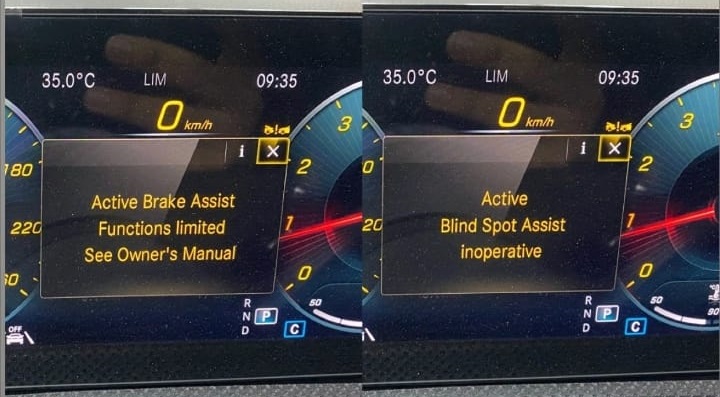
For more details in the following link;
Active Brake Assist Functions Limited Mercedes : Case Study & Solution
How to Prevent the “Active Brake Assist Functions Limited” Warning in the Future
Keep Radar Sensors Clean and Unobstructed
- – In winter, gently clear ice buildup without scratching or damaging the sensor cover.
- – Regularly inspect the front bumper area where the radar sensor is located.
- – Remove dirt, snow, ice, or dead insects that can block the radar signal.
Protect the Sensor During Car Washes
- – Avoid high-pressure jets directly on the sensor.
- – Do not scrub the radar area harshly, as it could misalign or damage the sensor.
- – Prefer touchless car washes or wash manually with care near the sensor.
Recalibrate After Repairs or Accidents
- – Any repairs involving the front bumper, windshield, or grille can disturb sensor alignment.
- – After replacing the windshield or repairing collision damage, always request a radar recalibration at a professional workshop.
Schedule Regular Maintenance
- – During routine service visits, ask technicians to check the radar sensor alignment and its electrical connections.
- – A periodic scan for fault codes can help detect minor issues before they cause major malfunctions.
Watch for Environmental Factors
- – Avoid following too closely behind vehicles that kick up excessive dirt, sand, or snow.
- – Be cautious in extreme weather conditions fog, heavy rain, or snow can sometimes trigger temporary warnings, but they should clear once conditions improve.
Summary Table
| Preventive Action | Why It Matters |
|---|---|
| Clean the sensor | Avoid signal obstruction |
| Protect during washes | Prevent misalignment or damage |
| Recalibrate after repairs | Ensure accurate readings |
| Regular maintenance | Detect hidden issues early |
| Avoid harsh environments | Minimize false warnings |
| Maintain battery health | Prevent electronic malfunctions |
Where is the radar sensor on a Mercedes E Class?
The radar sensor is typically located behind the front bumper on the right side as you see in the image below. This position allows the sensor to have an unobstructed view of the road ahead, which is crucial for its role in the active brake assist mercedes system and other driver assistance features.
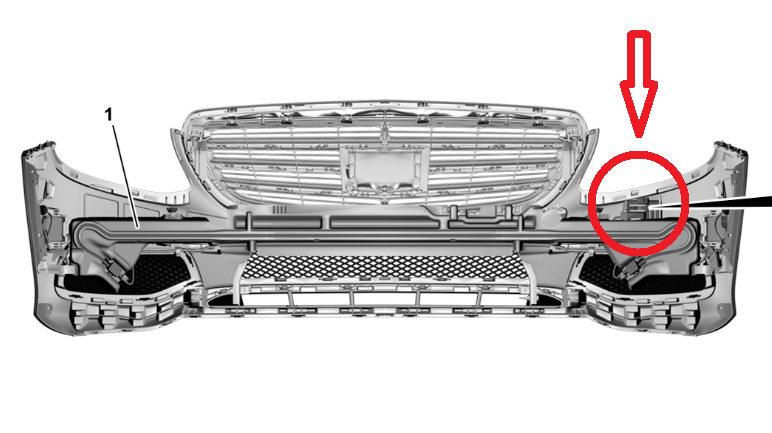
How to remove the Mercedes E-Class W213 radar sensor ?
Removing the radar sensor on a Mercedes E-Class W213 requires careful handling, as the sensor is a sensitive component crucial to the vehicle’s Active Brake Assist system. Here’s a general step-by-step guide on how to remove the radar sensor:
- 1: Remove the front bumper.
- 2: Remove the shock absorber from the front bumper.
- 3: Remove the pedestrian protection sensors along with the shock absorber from the front bumper.
- 4: Unlock the electrical connector and disconnect it.
- 5: Unscrew the screw and remove the bracket.
- 6: Remove the Active Brake Assist unit from the front bumper.
How does a Mercedes emergency brake work?
At the heart of the operation of active emergency brake assist are cutting-edge technologies. Radar sensor systems, acting as the vehicle’s eyes, continuously scan the environment to detect any potential obstacles.
Meanwhile, software and algorithms analyze these data in real-time and make the crucial decision to brake or not. This symbiosis between hardware and software forms the cornerstone of this revolutionary system.
Simultaneously, the Mercedes assistance system primes the emergency brake assist for imminent braking.
Emergency braking is triggered as soon as the driver firmly presses the brake pedal, typically at around 4 mph (7 km/h), when approaching a vehicle or pedestrian critically. A periodic alert signal sounds, and the distance warning light on the instrument cluster flashes.

What are the limitations of brake assist?
Brake Assist System Limits
Despite its ingenuity, emergency braking is not infallible. Adverse weather conditions, such as heavy rain or dense fog, can hinder the performance of sensors.
Current technological limitations, particularly regarding visibility and blind spots, underscore the importance of ongoing improvement and regular calibration of the system.
Can I drive with brake assist light on?
Driving with the brake assist light on is generally not recommended, as it indicates a potential issue with the vehicle’s braking system. While your car’s basic braking function may still work, the specific problem could affect features like emergency braking or collision avoidance, which are crucial for safety.
Here are some steps to take if the brake assist light comes on:
- 1. Check the Owner’s Manual: Follow any guidance provided for dealing with the warning light.
- 2. Drive Cautiously: If you must drive, do so with extra caution, keeping a safe distance from other vehicles and avoiding sudden maneuvers.
- 3. Seek Professional Help: Have your vehicle inspected by a qualified technician as soon as possible to diagnose and address the issue.
Ignoring the warning could compromise your safety and that of others on the road, so it’s important to address the issue promptly.
What is the recall on Mercedes Active brake assist functions Limited?
Mercedes-Benz issued a recall in 2019 affecting over 2,700 vehicles due to software errors in the radar sensor control units, which could impair the Active Brake Assist function.
This malfunction might prevent the system from automatically applying brakes in critical situations, increasing the risk of a collision.
The recall encompassed various models, including:
2019 Mercedes-Benz C-Class (C300, C43 AMG, C63 AMG)
2019 Mercedes-Benz CLS-Class (CLS450, CLS53 AMG)
2019 Mercedes-Benz E-Class (E300, E450, E53 AMG, E63S AMG)
2019 Mercedes-Benz S-Class (S450, S560, S63 AMG, S65 AMG)
2019 Mercedes-Benz AMG GT53 Coupe
2020 Mercedes-Benz GLC 300 Coupe
2020 Mercedes-Benz GLE-Class (GLE350, GLE450)
Owners of these models were advised to contact their local Mercedes-Benz dealership to have the radar sensor control unit software updated, resolving the issue with the Active Brake Assist system.
If you’re experiencing an “Active Brake Assist Functions Limited” warning in your Mercedes-Benz, it may be due to various factors, including sensor obstruction, software issues, or hardware malfunctions. Common causes include dirty or blocked sensors, low battery voltage, or damaged radar sensors.
It’s crucial to address this warning promptly, as it indicates that the brake assist function may not be operating correctly, potentially compromising vehicle safety. Consulting a qualified Mercedes-Benz technician for a thorough diagnosis and appropriate repairs is recommended.
Frequently Asked Questions
How can I reset the Active Brake Assist warning?
Sometimes cleaning the radar sensor and clearing fault codes with a diagnostic scanner can reset the system. However, if the fault persists, a professional recalibration or repair is necessary.
What are the most common causes of this warning?
– Dirty or blocked radar sensor
– Misaligned or damaged sensor after a collision
– Faulty wiring or control module
– Software issues or calibration errors
Where is the radar sensor located?
The radar sensor is usually mounted behind the front bumper, near the grille or emblem. It should always remain clean and unobstructed.
Do I need a professional to fix it?
If cleaning the sensor and clearing codes don’t resolve the issue, you’ll need a professional mechanic with the right tools to diagnose and recalibrate or replace components.
How much does it cost to fix the Active Brake Assist system?
Costs vary depending on the cause, cleaning is free, recalibration may cost $50–$200 and replacing a sensor can cost several hundred dollars.

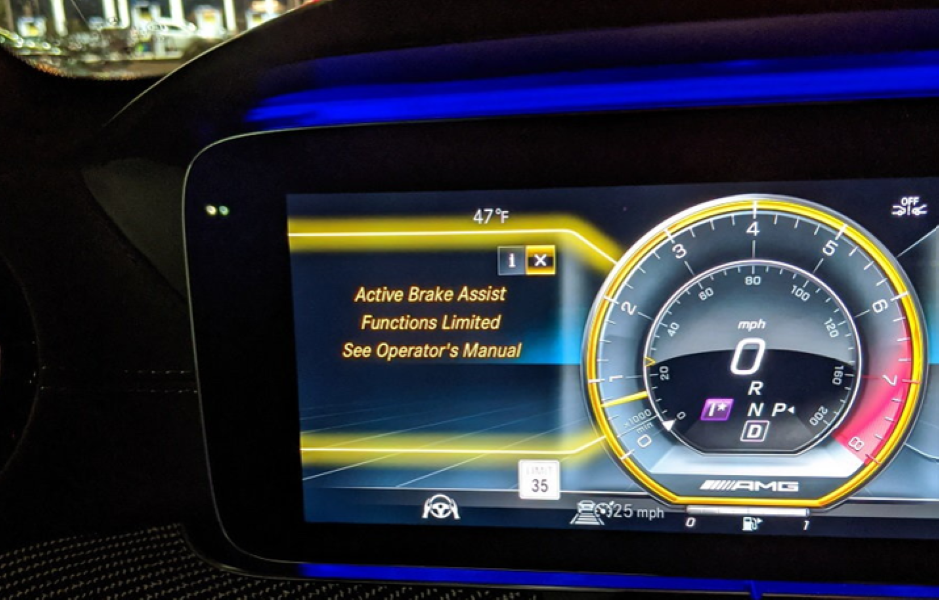
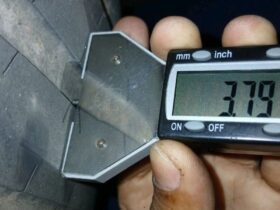
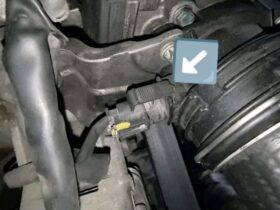



Leave a Reply